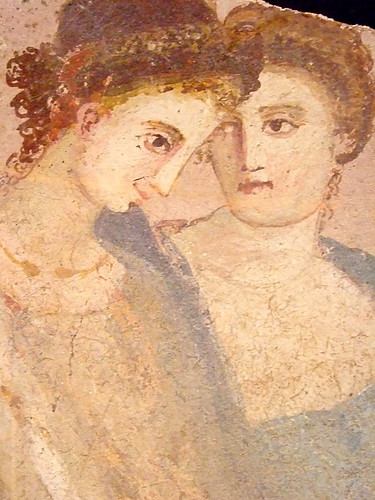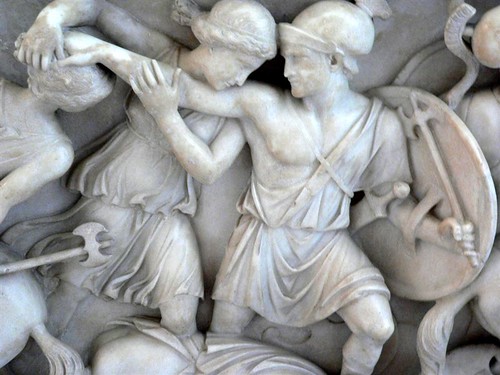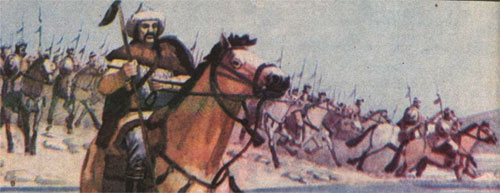
I mentioned in a post about Steven Saylor's new novel "Roma" that I was surprised at how long the Gauls "sacked " Rome - almost seven months. It's no wonder the threat of a Gaul invasion remained in the Roman consciousness for centuries. However, politicians of the late Roman Republic did not overlook the opportunity to exploit this common fear either to accomplish their goals. Both Cicero of the Optimates and Julius Caesar of the Populares manipulated this "organizational memory" to their advantage:
"Most of the migrating Gauls who invaded the Italian peninsula in
the early fourth century B.C. had settled down to farm the Po valley;
the sack of Rome in about 390 B.c., whose memory stayed vivid in
Roman national tradition, was the work of outlying stragglers, a roaming
band of Senones. Intermittent conflicts with the Po valley tribes
ended with the whole area coming under Roman control c.190 B.c.;
even Hannibal had raised only belated and partial support there. It
was not Celtic tribes but Germans coming from further afield, the
Cimbri and Teutoni, who in 109-101 B.C. invaded the Transalpine
province, defeated three Roman armies, and finally were defeated by
Marius, the Teutoni at Aix-en-Provence and the Cimbri in northern
Italy at Vercellae. Twenty years later, Romans apparently felt secure
enough to own and operate farms in the Province (Cicero, pro
Quinctio 12ff.; cf. Varro R.R. 3.12.1), though there are some signs of
restlessness. Pompey encountered some obstruction from tribesmen on
his way through Transalpine Gaul in 76 B.C. (Cicero, de imp. Cn.
Pomp. 30).
Thus, there had been little real danger since the early second
century; however, the lurking fear remained and was exploited by
Roman politicians. As is well known, Cicero made use of a group of
envoys from the Allobroges as double agents, and possibly to some
extent agents provocateurs, to secure evidence for the arrest of the
Catilinarian conspirators. These envoys were in Rome to make
representations about the exactions of the Roman governor and
Roman money-lenders (Sallust, Cat. 40). They evidently failed to
obtain satisfaction, because in the following two years there was an
uprising amongst them (Caesar B.G. 1.6, 44).' At the time in 63 B.c.,
however, they were willing to help the Roman consul, perhaps because
he had given them some sort of undertaking as the price of their help.
His own explanation of the reason for their cooperation is no explanation
at all. The cause, Cicero surmises, was divine intervention
(In Catil. 3.22). For the purposes of his indictment of the conspirators
the Gauls must not be allowed themselves to have any sentiments
towards Rome other than hostility and aggression. They are 'unknown
and barbarous' and Lentulus and his associates would never have
confided in them if the gods had not robbed them of their commonsense.
Gaul is a race imperfectly pacified, the only nation remaining
which appears to have the power - and not to lack the will - to make
war on Rome. In the fourth Catilinarian, Cicero speaks in terms that
recall, without actually mentioning, the sack by the Senones. The aim
of the conspirators' activity has been to set up the tribe of the
Allobroges amid the ruins of Rome and on the ashes of the government
overthrown (4.12 - compare the way in which in the third
Catilinarian 3.9, the Gauls' evidence that they had been told to supply
cavalry is sandwiched between references to the conspirators' alleged
intention to commit wholesale massacre and arson). In short, Cicero
trusted the Allobrogic envoys; but he represents them as untrustworthy.
Caesar represents the danger to Rome from the Gauls as arising in
part from the nature of the Gauls themselves and in part from the
pressure they were experiencing from Germanic peoples. Different
areas of Gaul varied in their degree of political development. Those
areas nearest the Province show most signs of having come under the
influence of Roman political institutions, those further away progressively
less so. The Celtic tribes in particular, of whom Caesar
singles out for mention three important sections - the Arverni, the
Aedui, and the Helvetii - had already abandoned hereditary kingship
and instead had magistrates, annually elected and answerable to
councils, and public codes of law (see, e.g., 1.3-4, 16, 19; 7.4, 32ff.).2
The tribes further away, the northern Celts, the Aremorican tribes,
and the Belgae, both those on the mainland and those in Britain, still
retained kingship. The Germanic tribes beyond the Rhine, according
to Caesar, were still pastoral, without settled agriculture, and accepted
a centralized authority only in time of war (6.22-23).
The first of these groups, i.e., primarily the Celtic peoples, were
evolving a type of government that was familiar to the Romans and with
which they could deal by familiar methods. Treaties and promises of
friendship already existed between some of them and the Romans.
However, these governments, according to Caesar, were still far from
stable. Of the Gauls in general he remarks (6.1 l), 'Not only every
tribe, canton, and subdivision of a canton, but almost every family,
is divided into rival factions'. This, he says, is an ancient custom,
providing the common people with patrons and protectors among the
more powerful. The same factions, however, could be and were used
to support attempts to seize monarchic power. Powerful men, says
Caesar, and those who could afford to hire mercenaries, commonly
usurped thrones (2.1). In the context, he appears to be referring to
the Belgae, but in his narrative elsewhere we find monarchic ambitions
imputed to the Helvetian Orgetorix (1.2), the Aeduan Dumnorix
(1.9ff.), and hinted at in Vercingetorix (7.4, 20), while the anxiety
shown in the treatment of suspected usurpers is reminiscent of Livy's
accounts of the hypersensitive reactions of citizens of the infant Roman
republic.
Orgetorix' kingly ambitions are said to have induced him to organize
a conspiracy and to persuade his people, by holding out prospects of
conquering the whole of Gaul, to emigrate en masse. He then persuaded
Dumnorix the Aeduan and a Sequanian named Casticus to
make similar attempts to seize royal power. Their ultimate aim, according
to Caesar, was to set up an empire, under their joint control,
over the whole of Gaul. Caesar, then, in moving against the Helvetii,
was warding off the imminent rise of a strong, united, and imperialistic
power in Gaul. The Helvetic invasion, on this view, had nothing
to do with the Aedui and their problems as a people, but originated
in the personal treasonable ambitions of the individuals named. Yet
the unmasking of Orgetorix apparently does not lead to Dumnorix'
fall from influence among the Aedui, and the Helvetii still persist
with their invasion - as they naturally would, had they in fact been
answering an appeal for help from the Aeduan nation.
The Aedui, to whom the Senate had accorded the title 'Brothers
and Kinsmen of the Roman People' (1.33) had in 61 B.C. approached
the Romans for help against the Sequani and Ariovistus, but without
success (6.12). Caesar as consul in 59 B.C. had secured for
Ariovistus the titles 'King' and 'Friend of the Roman People', possibly in the hope of delaying the eruption of trouble for Rome's clients
beyond the frontier of the Transalpine Province, while he pursued his
original intention, using the legions based at Aquileia (1.10), of an
Illyrian campaign. The campaigns against the Helvetii and Ariovistus,
being beyond the frontier of the Province, needed justification, and
this Caesar is at pains to provide. The Helvetii were a threat to the
Province (1 .lo, 30) -not very plausible geographically, had they really
been bound for the country of the Santoni; injuries to Rome's allies
(1.11, 14) and to the Romans themselves in the past (1.7, 12, 13, 30)
are also cited. The defence of loyal allies is also mentioned as a reason
for opposing Ariovistus (1.45), despite Caesar's previous fobbing-off
of those same allies. Since Ariovistus was a 'Friend' the case against
him is harder to establish. In the end, Caesar lays most stress on
Ariovistus' arrogance and truculence and on the 'German menace'.
'If the Germans gradually formed a habit of crossing the Rhine and
entering Gaul in large numbers, he saw how dangerous it would be for
the Romans. If these fierce Barbarians occupied the whole of Gaul, the
temptation would be too strong for them; they would cross the
frontier into the Province, as the Cimbri and Teutoni had done before
them and march on Italy' (1.33; cf. 1.40). Ariovistus is allowed in
1.44 to suggest that to be a Friend of the Roman People ought to
be the basis of advantages for both parties. Caesar does not pursue the
implications of this. The answer he provides for his Roman audience
(1.45) is that Rome had the prior claim to the area, should she choose
to exercise it." -
Greece & Rome, 2nd Ser., Vol. 30, No. 2. (Oct., 1983)












